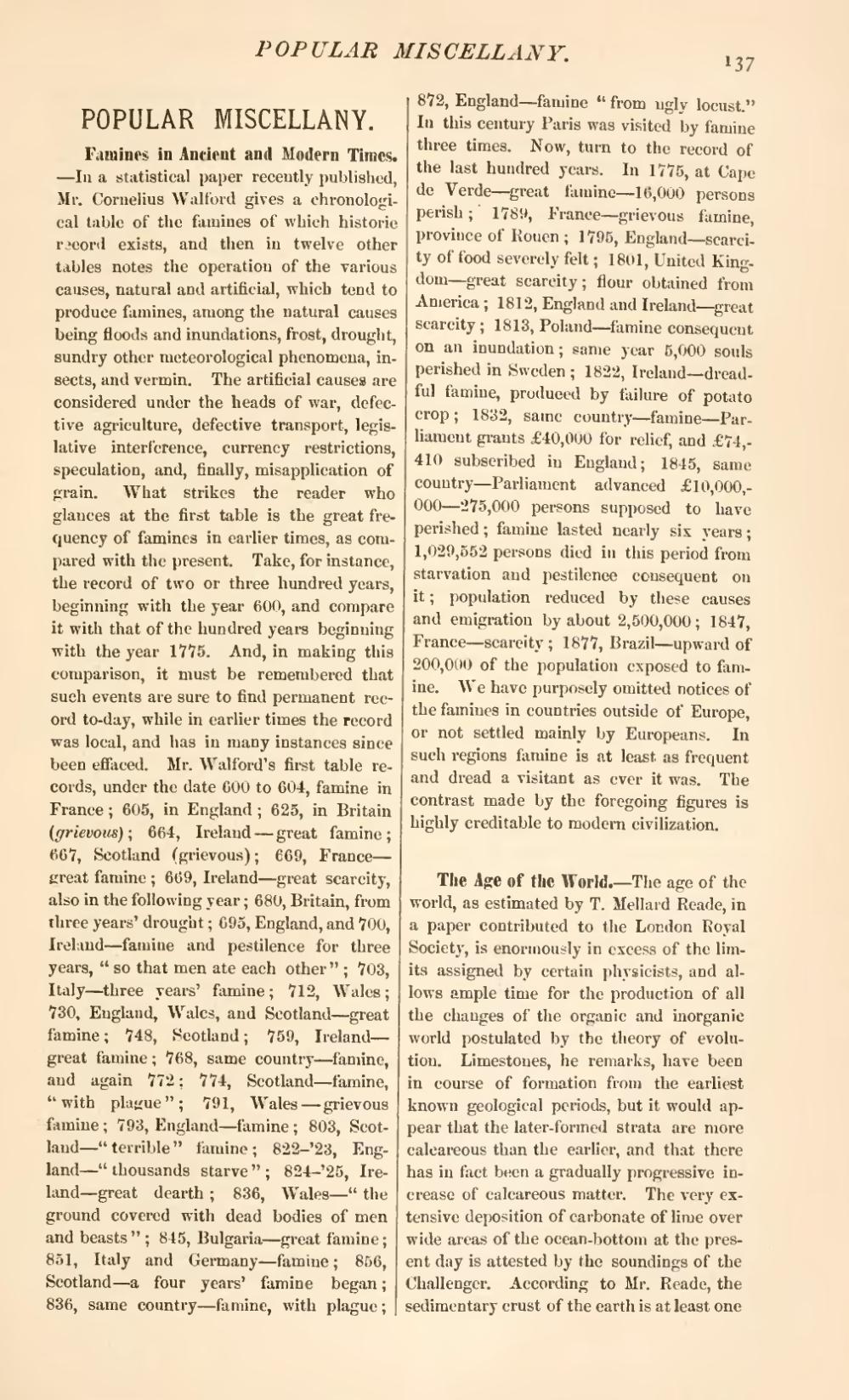Famines in Ancient and Modern Times.—In a statistical paper recently published, Mr. Cornelius Walford gives a chronological table of the famines of which historic record exists, and then in twelve other tables notes the operation of the various causes, natural and artificial, which tend to produce famines, among the natural causes being floods and inundations, frost, drought, sundry other meteorological phenomena, insects, and vermin. The artificial causes are considered under the heads of war, defective agriculture, defective transport, legislative interference, currency restrictions, speculation, and, finally, misapplication of grain. What strikes the reader who glances at the first table is the great frequency of famines in earlier times, as compared with the present. Take, for instance, the record of two or three hundred years, beginning with the year 600, and compare it with that of the hundred years beginning with the year 1775. And, in making this comparison, it must be remembered that such events are sure to find permanent record to-day, while in earlier times the record was local, and has in many instances since been effaced. Mr. Walford's first table records, under the date 600 to 604, famine in France; 605, in England; 625, in Britain (grievous); 664, Ireland great famine; 667, Scotland (grievous); 669, France—great famine; 669, Ireland great scarcity, also in the following year; 680, Britain, from three years' drought; 695, England, and 700, Ireland—famine and pestilence for three years, "so that men ate each other"; 703, Italy—three years' famine; 712, Wales; 730, England, Wales, and Scotland—great famine; 748, Scotland; 759, Ireland—great famine; 768, same country—famine, and again 772; 774, Scotland—famine, "with plague"; 791, Wales—grievous famine; 793, England—famine; 803, Scotland—"terrible" famine; 822-'23, England—"thousands starve"; 824-'25, Ireland—great dearth; 836, Wales—"the ground covered with dead bodies of men and beasts"; 845, Bulgaria—great famine; 851, Italy and Germany—famine; 856, Scotland—a four years' famine began; 836, same country—famine, with plague; 872, England—famine "from ugly locust." In this century Paris was visited by famine three times. Now, turn to the record of the last hundred years. In 1775, at Cape de Verde—great famine—16,000 persons perish; 1789, France—grievous famine, province of Rouen; 1795, England—scarcity of food severely felt; 1801, United Kingdom—great scarcity; flour obtained from America; 1812, England and Ireland—great scarcity; 1813, Poland—famine consequent on an inundation; same year 5,000 souls perished in Sweden; 1822, Ireland—dreadful famine, produced by failure of potato crop; 1832, same country—famine—Parliament grants £40,000 for relief, and £74,410 subscribed in England; 1845, same country Parliament advanced £10,000,000—275,000 persons supposed to have perished; famine lasted nearly six years; 1,029,552 persons died in this period from starvation and pestilence consequent on it; population reduced by these causes and emigration by about 2,500,000; 1847, France—scarcity; 1877, Brazil—upward of 200,000 of the population exposed to famine. We have purposely omitted notices of the famines in countries outside of Europe, or not settled mainly by Europeans. In such regions famine is at least as frequent and dread a visitant as ever it was. The contrast made by the foregoing figures is highly creditable to modern civilization.
The Age of the World.—The age of the world, as estimated by T. Mellard Reade, in a paper contributed to the London Royal Society, is enormously in excess of the limits assigned by certain physicists, and allows ample time for the production of all the changes of the organic and inorganic world postulated by the theory of evolution. Limestones, he remarks, have been in course of formation from the earliest known geological periods, but it would appear that the later-formed strata are more calcareous than the earlier, and that there has in fact been a gradually progressive increase of calcareous matter. The very extensive deposition of carbonate of lime over wide areas of the ocean-bottom at the present day is attested by the soundings of the Challenger. According to Mr. Reade, the sedimentary crust of the earth is at least one
